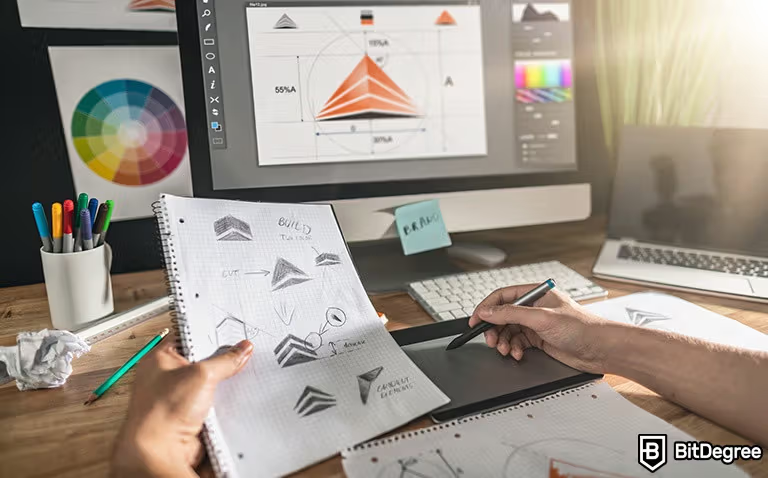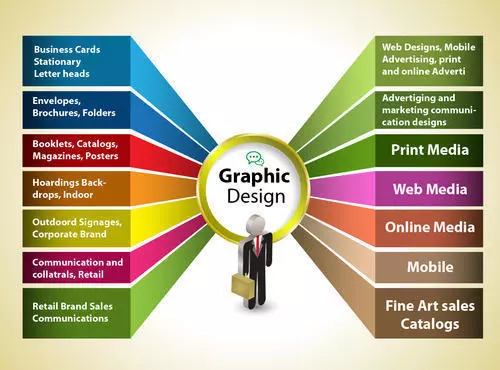Becoming a graphic designer requires a mix of creativity, technical skills, and business acumen. Whether you’re interested in creating logos, designing websites, or crafting compelling advertisements, graphic design offers a diverse and exciting career path with endless possibilities for growth and innovation.
- Learn about become a graphic designer dynamic and creative profession that blends artistic vision with technical expertise to communicate ideas visually.
Moreover, from mastering design principles to building a creative portfolio and obtaining certifications, we’ll explore how to stand out as a professional graphic designer in a competitive industry. - If you like colors, fonts, images, and are good at making compositions, then this field is really good for you.
In addition, various tools and software are used, such as Adobe Photoshop, Adobe Illustrator, CorelDraw, etc. By utilizing these tools, you can create visually appealing designs. - Furthermore, some of the main work in this field includes designing logos, posters, wallpapers, banners, social media posts, stationery, and much more.
In recent years, we have seen a growing demand for skilled designers, and it is still increasing. Ultimately, this is a field of imagination where ideas should be unique. Therefore, it is a perfect career choice.

Table of Contents
what’s a graphic designer?
A graphic designer is a professional who creates visual content to communicate messages effectively. By combining typography, images, colors, and layout, graphic designers craft designs that inform, inspire, and captivate audiences. Their work can be found everywhere—from print materials like brochures and posters to digital platforms like websites, social media, and mobile apps.
Graphic designers use various tools and techniques to bring ideas to life. They work with drawn, painted, photographed, or computer-generated images, and they design letterforms that make up typefaces used in movie credits, advertisements, books, menus, and more. By organizing typography, images, and even the “white space” around them, designers create visuals that communicate messages clearly and effectively.
Graphic design surrounds us in everyday life. From the gum wrapper in your pocket to the billboard on the highway and the T-shirt you’re wearing, graphic design informs, persuades, organizes, and entertains. It also plays a vital role in branding, helping businesses and organizations establish a unique identity.
How to Become a Graphic Designer: To become a graphic designer, you need creativity, technical skills, and problem-solving abilities. Start by learning the basics of design principles, like color theory, typography, and composition. Familiarize yourself with industry-standard software such as Adobe Photoshop, Illustrator, InDesign, or tools like Figma and Sketch. Pursue formal education, like a degree or certification in graphic design, or self-learn through online resources and practice. A strong portfolio is essential to showcase your skills and attract clients or employers.

Graphic Design In-Demand Career:
Becoming a graphic designer offers a unique blend of creativity, innovation, and opportunity. Here are key reasons to consider this exciting career transformation:
Become a Graphic Designer: Explore a Dynamic and In-Demand Career
The demand for skilled graphic designers continues to grow as businesses, organizations, and individuals recognize the power of visual communication. If you’re considering a career in graphic design, now is the perfect time to step into this versatile and rewarding field.
Web and App Development:
With the rise of digital platforms, the need for visually appealing and user-friendly websites and mobile apps has skyrocketed. Businesses are investing heavily in UI/UX design to enhance customer experiences, making graphic designers integral to their success.
Content Marketing:
Graphic designers play a vital role in creating engaging content such as infographics, banners, and promotional visuals. These designs capture attention, drive engagement, and help businesses retain online audiences.
E-commerce Growth:
As online shopping thrives, businesses rely on graphic designers to create eye-catching product images, advertisements, and branding that make them stand out in a competitive market.
High Demand for Branding and Identity Design:
- Business Growth: Companies constantly seek to build or refresh their brand identity. Graphic designers craft logos, business cards, and brand guidelines that reflect a company’s mission and values.
- Competitive Edge: Strong visual branding gives businesses an edge in crowded markets, showcasing the importance of design in achieving success.
Expanding Opportunities in Creative Fields:
- Entertainment Industry: Designers are key players in entertainment marketing, creating movie posters, album covers, and video game artwork.
- Publishing and Advertising: Graphic designers craft captivating book layouts, magazine spreads, and billboard ads that communicate effectively.
- Event Promotion: From flyers to digital invitations, professional design skills are essential for promoting events.
Versatility and Transferable Skills:
Graphic design skills open doors in industries like healthcare, education, real estate, and non-profits, offering job security and flexibility. Designers can also branch into animation, motion graphics, or web development, broadening career paths.
Growing Need for Personalized and Custom Designs:
Small businesses and independent creators often seek custom designs, providing opportunities for freelancers and boutique agencies. Tailored designs help brands connect with niche audiences, increasing demand for innovative designers.
Rise of Freelancing and Remote Work:
Platforms like Upwork and Fiverr allow designers to find global clients, making freelancing a viable and flexible career choice. Remote work opportunities also enable collaboration with international teams.
Innovation in Design Tools and Technologies:
Advanced tools like Adobe Creative Suite streamline design processes, attracting new talent to the profession. Emerging technologies like artificial intelligence and augmented reality keep the field dynamic and future-ready.
Increased Focus on Visual Storytelling:
In a world overwhelmed with information, businesses rely on graphic design to simplify complex ideas through visuals. Infographics, data visualizations, and video graphics are in high demand across marketing, journalism, and education.
Cultural and Social Impact:
Graphic designers influence societal conversations through impactful visuals for campaigns, activism, and awareness programs. The ability to shape public opinion adds significance to this career.
Continuous Learning and Creative Satisfaction:
Graphic design offers endless opportunities to learn, experiment, and push creative boundaries. Designers blend artistry with problem-solving, creating work that is both impactful and personally fulfilling.
Becoming a graphic designer means joining a career that combines artistic expression, practical application, and market demand. With opportunities for growth, innovation, and creative satisfaction, graphic design remains an exciting and in-demand profession.
What does a graphic designer do?
A graphic designer’s role involves creating impactful visual content through a mix of creativity and technical skills.
Their work includes developing brochures, magazines, corporate reports, and print advertisements, as well as retouching photos. The process often starts with brainstorming rough ideas, either by sketching or using design tools like Adobe Illustrator, Affinity Designer, Adobe Photoshop Adobe In Design.
Once the initial concept is ready, designers use advanced tools and technology to transform their ideas into polished visual concepts that communicate messages effectively through images and art.
The responsibilities of a graphic designer vary based on client or company needs but broadly include crafting visual content for marketing campaigns, digital displays, and more. Key tasks involve:
- Meeting clients to understand project scope
- Advising on strategies to engage specific audiences
- Creating designs that identify a product or convey messages
- Designing illustrations, logos, and web content
- Choosing colors, layouts, and text styles
- Presenting designs to clients
- Making revisions based on feedback
- Ensuring the final design is error-free
Graphic design requires attention to detail, adaptability, and excellent communication to deliver creative and effective visual solutions.
Five steps to becoming a graphic designer
- Learn graphic design principles
- Enroll in a graphic design course
- Learn key graphic design tools
- Work on your own projects to develop your graphic design skills
- Develop a portfolio to showcase your graphic design work
step 1
Learn Graphic Design Principles
- To become a Graphic Designer, you first need a solid understanding of the principles of graphic design. Good design is carefully crafted.
- It involves a lot of planning and requires an expertise in applying design theory and principles.
- Graphic Designers need to consider elements such as lines, color, shape, space, texture, typography, scale, dominance and emphasis, and harmony.
- All of these elements impact a design and can shape how an audience feels.
step 2
Enroll In a Graphic Design Course
- To become a graphic designer, a course is a great starting point. It teaches you the basics of design and helps you build practical skills through hands-on projects. You’ll also connect with mentors and peers, which can be invaluable for growing your network.
- Most graphic design courses cover essential topics like color theory, typography, layout, and tools like design software. Some go deeper into core principles of graphic design, giving you a strong foundation.
- Whether you prefer a structured academic program or a flexible online course, there are plenty of options to fit your schedule and learning style. Find one that works for you, and start your journey to becoming a graphic designer!
step 3
Learn Key Graphic Design Tools
- There are a variety of tools that Graphic Designers use. Most commonly, they work with graphic design software.
- Adobe Creative Cloud is the standard for most Graphic Designers. You will want to become familiar with Adobe Photo Shop, Adobe Illustrator, and InDesign, as the majority of design work can be created through these tools.
- There are many user guides and training resources widely available.
- To get started, you may want to take a look through Adobe’s series of tutorials.
step 4
Develop Your Graphic Designer Skills
- The best way to grow your skills and master graphic design software is to work on your own design projects.
- To get started, you can create mock ads and logos for real or made-up companies. You can also take a company’s existing designs and try creating a new design — this is good practice for identifying and designing for target audiences.
- Another option is to volunteer with local non-profits or brands. Offer your design skills to these organizations so you get more practice, as well as gain real-world experience.
step 5
Develop a Portfolio to Showcase Your Graphic Designer Work
- A strong portfolio is essential for any Graphic Designer. Your portfolio can include projects you completed for a course, as well as personal or work projects.
- Focus on quality over quantity. Your portfolio is the first impression that potential employers or clients will see, so select work that demonstrates your design skills and interests.